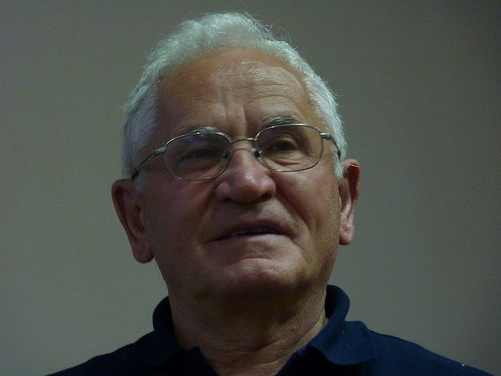Quantum Chaos—Dedicated to Professor Giulio Casati on the Occasion of His 80th Birthday
A special issue of Entropy (ISSN 1099-4300). This special issue belongs to the section "Quantum Information".
Deadline for manuscript submissions: closed (31 March 2023) | Viewed by 84025
Special Issue Editor
Interests: quantum chaos; classical chaos; generic/mixed-type systems; chaotic diffusion; dynamical localization; structure of chaotic eigenstates; statistical properties of phase space localized chaotic eigenstates; statistical properties of energy spectra; semiclassical approximations; WKB theory; time-dependent classical and quantum Hamilton systems
Special Issue Information
Dear Colleagues,
The aim of this Special Issue is to collect original research articles on the most recent research in quantum chaos, as well as comprehensive review articles covering quantum chaos from either a theoretical or experimental viewpoint. A review can focus on either a wide context or the recent research contributions of the author(s) and related works of other researchers on the same topic. For example, reviews of results obtained so far on the out-of-time-order correlator or on dynamical localization, etc., are welcome. Topics can include any subject in the area of quantum or wave chaos, as well as subjects in classical chaos in a manner that is relevant to quantum chaos.
Moreover, we welcome articles focusing on the mathematical methods and tools used to study quantum chaos, such as random matrix theories—including supersymmetric methods, semiclassical methods and theoretical results, and sophisticated advanced numerical methods. Needless to say, papers can address phenomena both in the time evolution of systems as well as their stationary properties, such as the structure and properties of the eigenstates of chaotic systems.
Research focusing on applications is welcome as well, such as research in microwave and optical systems; in acoustics; in mesoscopic and nano systems; and in atomic, molecular, and solid-state physics. In particular, works on quantum many-body systems are welcome, as well as their classical counterparts, if they exist.
 Professor Giulio Casati has had an admirable impact on physics, especially in classical and quantum chaos, where his work over more than five decades has laid down the foundations, but also in many other areas of theoretical physics and applications.
Professor Giulio Casati has had an admirable impact on physics, especially in classical and quantum chaos, where his work over more than five decades has laid down the foundations, but also in many other areas of theoretical physics and applications.
Moreover, he has been and still is an active organizer of science, both in creating and leading elite academic and research institutions, as well as in organizing many world-top level conferences, workshops, and schools. In particular, he has been supporting young researchers all over the world in an important way.
In recognition of his creative and influential life opus and of his plentiful contributions for the good of our scientific community, this Special Issue is dedicated to him on the occasion of his 80th birthday (9 December 2022).
Prof. Dr. Marko Robnik
Guest Editor
Manuscript Submission Information
Manuscripts should be submitted online at www.mdpi.com by registering and logging in to this website. Once you are registered, click here to go to the submission form. Manuscripts can be submitted until the deadline. All submissions that pass pre-check are peer-reviewed. Accepted papers will be published continuously in the journal (as soon as accepted) and will be listed together on the special issue website. Research articles, review articles as well as short communications are invited. For planned papers, a title and short abstract (about 100 words) can be sent to the Editorial Office for announcement on this website.
Submitted manuscripts should not have been published previously, nor be under consideration for publication elsewhere (except conference proceedings papers). All manuscripts are thoroughly refereed through a single-blind peer-review process. A guide for authors and other relevant information for submission of manuscripts is available on the Instructions for Authors page. Entropy is an international peer-reviewed open access monthly journal published by MDPI.
Please visit the Instructions for Authors page before submitting a manuscript. The Article Processing Charge (APC) for publication in this open access journal is 2600 CHF (Swiss Francs). Submitted papers should be well formatted and use good English. Authors may use MDPI's English editing service prior to publication or during author revisions.
Keywords
- theoretical and experimental quantum or wave chaos
- time evolution of quantum systems
- structure of eigenstates and energy spectra
- random matrix theories
- supersymmetric methods
- semiclassical methods and results
- advanced numerical methods
- applications in wave systems
- mesoscopic systems
- nano systems
- atomic, molecular and solid-state systems
- quantum many body systems
Benefits of Publishing in a Special Issue
- Ease of navigation: Grouping papers by topic helps scholars navigate broad scope journals more efficiently.
- Greater discoverability: Special Issues support the reach and impact of scientific research. Articles in Special Issues are more discoverable and cited more frequently.
- Expansion of research network: Special Issues facilitate connections among authors, fostering scientific collaborations.
- External promotion: Articles in Special Issues are often promoted through the journal's social media, increasing their visibility.
- e-Book format: Special Issues with more than 10 articles can be published as dedicated e-books, ensuring wide and rapid dissemination.
Further information on MDPI's Special Issue polices can be found here.







